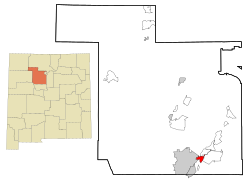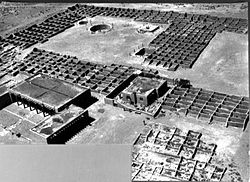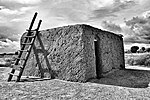Bernalillo, New Mexico
Bernalillo, New Mexico | |
|---|---|
 Bernalillo Town Hall, May 2009 | |
 Location of Bernalillo, New Mexico | |
| Coordinates: 35°18′50″N 106°33′08″W / 35.31389°N 106.55222°W | |
| Country | United States |
| State | New Mexico |
| County | Sandoval |
| Founded | 1695 |
| Government | |
| • Mayor | Jack Torres |
| Area | |
• Total | 5.296 sq mi (13.717 km2) |
| • Land | 5.258 sq mi (13.619 km2) |
| • Water | 0.038 sq mi (0.099 km2) |
| Elevation | 5,053 ft (1,540 m) |
| Population | |
• Total | 8,977 |
• Estimate (2023)[4] | 9,114 |
| • Density | 1,733/sq mi (669.2/km2) |
| Time zone | UTC−7 (Mountain (MST)) |
| • Summer (DST) | UTC−6 (MDT) |
| ZIP Code | 87004 |
| Area code | 505 |
| FIPS code | 35-06970 |
| GNIS feature ID | 2411678[2] |
| Sales tax | 6.94%[5] |
| Website | www |
Bernalillo (/ˌbɜːrnəˈliːjoʊ/) is a town in and the county seat of Sandoval County, New Mexico, United States.[6] The population was 8,977 at the 2020 census.[3]
Bernalillo is part of the Albuquerque Metropolitan Statistical Area.
History
[edit]Wine Festival
[edit]In the 1620s, the wine grape was introduced to Bernalillo by the Catholic priests and Spaniards. The wine industry grew rapidly since. Families were making their own wine and the vineyards were flourishing. The market dipped due to drought and floods. Slowly over time, the wine industry came back into Bernalillo and has sustained its health today, becoming a tradition and staple within the town itself.[citation needed]
The town has embraced its wine heritage and hosts the New Mexico Wine festival yearly during each Labor Day. The event brings in people from all of New Mexico as well as tourists. The event has served as an economic development project for the area as well.[7]
Geography
[edit]Bernalillo lies in the Rio Grande Valley of the Albuquerque Basin on the east bank of the Rio Grande. According to the United States Census Bureau, the city has a total area of 5.296 square miles (13.72 km2), of which 5.258 square miles (13.62 km2) is land and 0.038 square miles (0.10 km2), or 2.34% is water[1]
Demographics
[edit]| Census | Pop. | Note | %± |
|---|---|---|---|
| 1880 | 1,223 | — | |
| 1950 | 1,922 | — | |
| 1960 | 2,574 | 33.9% | |
| 1970 | 2,016 | −21.7% | |
| 1980 | 2,988 | 48.2% | |
| 1990 | 5,960 | 99.5% | |
| 2000 | 6,611 | 10.9% | |
| 2010 | 8,320 | 25.9% | |
| 2020 | 8,977 | 7.9% | |
| 2023 (est.) | 9,114 | [4] | 1.5% |
| U.S. Decennial Census[8] 2020 Census[3] | |||
2020 census
[edit]| Race | Number | Percent |
|---|---|---|
| White (NH) | 2,476 | 27.6% |
| Black or African American (NH) | 52 | 0.6% |
| Native American (NH) | 468 | 5.2% |
| Asian (NH) | 66 | 0.7% |
| Pacific Islander (NH) | 6 | 0.1% |
| Some Other Race (NH) | 29 | 0.3% |
| Mixed/Multi-Racial (NH) | 150 | 1.7% |
| Hispanic or Latino | 5,730 | 63.8% |
| Total | 8,977 | 100.0% |
As of the 2020 census, there were 8,977 people, 3,563 households, and 2,367 families residing in the town.[10] The population density was 1,837.7 inhabitants per square mile (709.5/km2). There were 3,801 housing units. The racial makeup of the town was 44.2% White, 0.7% African American, 6.6% Native American, 0.8% Asian, 0.1% Pacific Islander, 24.5% from some other races and 23.1% from two or more races. Hispanic or Latino of any race were 63.8% of the population.[11] 14.7% of residents were under the age of 18, 3.6% were under 5 years of age, and 25.2% were 65 and older.
2000 census
[edit]As of the 2000 census, there were 6,611 people, 2,309 households, and 1,724 families residing in the town. The population density was 1,436.9 inhabitants per square mile (554.8/km2). There were 2,473 housing units at an average density of 537.5 per square mile (207.5/km2). The racial makeup of the town was 60.17% White, 0.74% African American, 3.92% Native American, 0.20% Asian, 31.34% from other races, and 3.63% from two or more races. Hispanic or Latino of any race were 74.75% of the population. Most of these are descendants of colonial Spanish and Mexican settlers in the area from the 16th through the 19th century.
There were 2,309 households, out of which 40.8% had children under the age of 18 living with them, 49.1% were married couples living together, 18.6% had a female householder with no husband present, and 25.3% were non-families. 20.2% of all households were made up of individuals, and 6.9% had someone living alone who was 65 years of age or older. The average household size was 2.86 and the average family size was 3.30.
In the town, the population was spread out, with 31.0% under the age of 18, 9.9% from 18 to 24, 28.5% from 25 to 44, 21.4% from 45 to 64, and 9.2% who were 65 years of age or older. The median age was 32 years. For every 100 females, there were 93.9 males. For every 100 females age 18 and over, there were 91.4 males.
The median income for a household in the town was $30,864, and the median income for a family was $36,286. Males had a median income of $27,417 versus $22,125 for females. The per capita income for the town was $13,100. About 13.9% of families and 18.2% of the population were below the poverty line, including 25.4% of those under age 18 and 16.3% of those age 65 or over.
Education
[edit]Most of Bernalillo is in the Bernalillo Public Schools district. Some is in the Jemez Valley Public Schools district.[12] The former operates Bernalillo High School.
In popular culture
[edit]Anton Docher, who became known as "The Padre of Isleta", first served as a priest in Bernalillo after coming as a missionary to the United States from France. He later served for decades in Isleta.[13]
Bernalillo Courthouse is the setting for the marriage between Jimmy "Saul Goodman" McGill and Kim Wexler in Better Call Saul.
Bernalillo is mentioned several times in Willa Cather's 1927 novel Death Comes for the Archbishop.
Sam Shepard's play The Late Henry Moss is set "on the outskirts of" Bernalillo.
Bernalillo is mentioned and is the scene of part of the action in Ben Sanders book "American Blood" Allen and Unwin 2015
Gallery
[edit]- Historic Santuario de San Lorenzo, Bernalillo
- Entrance, Santuario de San Lorenzo
- Kuaua ruins, Coronado State Monument, 1940
- Downtown Bernalillo Rail Runner station, Bernalillo
- Pueblo Style House - Coronado State Monument
- US Route 550 with Sandia Mountains
See also
[edit]References
[edit]- ^ a b "2023 U.S. Gazetteer Files". United States Census Bureau. Retrieved June 16, 2024.
- ^ a b U.S. Geological Survey Geographic Names Information System: Bernalillo, New Mexico
- ^ a b c "Explore Census Data". United States Census Bureau. Retrieved June 16, 2024.
- ^ a b "City and Town Population Totals: 2020–2023". United States Census Bureau. June 16, 2024. Retrieved June 16, 2024.
- ^ "Bernalillo (NM) sales tax rate". Retrieved June 16, 2024.
- ^ "Find a County". National Association of Counties. Archived from the original on May 31, 2011. Retrieved June 7, 2011.
- ^ "Town of Bernalillo". Archived from the original on November 19, 2014. Retrieved September 12, 2016.
- ^ "Census of Population and Housing". United States Census Bureau. Retrieved June 4, 2015.
- ^ "P2 HISPANIC OR LATINO, AND NOT HISPANIC OR LATINO BY RACE – 2020: DEC Redistricting Data (PL 94-171) – Bernalillo town, New Mexico".
- ^ "US Census Bureau, Table P16: Household Type". United States Census Bureau. Retrieved June 16, 2024.
- ^ "How many people live in Bernalillo town, New Mexico". USA Today. Retrieved June 16, 2024.
- ^ "2020 CENSUS - SCHOOL DISTRICT REFERENCE MAP: Sandoval County, NM" (PDF). United States Census Bureau. Retrieved January 9, 2022.
- ^ Leo Crane. Desert Drums: the Pueblo Indians of New Mexico, 1540-1928. Rio Grande Press: 1972
External links
[edit]![]() Media related to Bernalillo, New Mexico at Wikimedia Commons
Media related to Bernalillo, New Mexico at Wikimedia Commons


 French
French Deutsch
Deutsch






